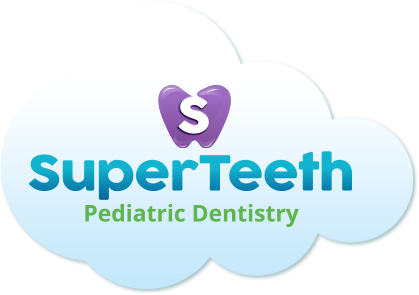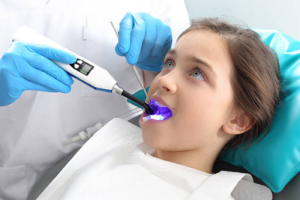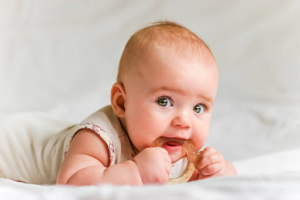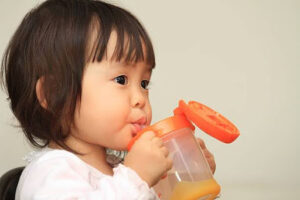At what age should be the first dental visit?
The American Academy of Pediatric Dentistry recommends the first visit to be at the time of the eruption of the first tooth and no later than 12 months of age. The developing dentition and occlusion should be monitored throughout eruption at regular clinical examinations.
What should we do at home to care for my child or baby’s teeth?
– Begin oral care early. Wipe your baby’s gums with clean gauze after each feeding. As soon as that first tooth appears start using a soft toothbrush with fluoridated toothpaste, brushing at least once a day before bedtime.
– Never let your baby or toddler fall asleep with a bottle or sippy cup containing sugary liquids or a pacifier dipped in sugar or honey. Only give your baby water or a clean pacifier.
– Do not continue to nurse once baby is asleep or has stopped sucking on the bottle.
– Start to teach your child to drink from a cup at the age of one or as they approach to it.
– Check your baby’s teeth regularly. If you see white or stained areas on the teeth, take him or her to the pediatric dentist for a consultation as soon as possible.
– Be sure to feed your baby a balanced, healthy diet. Sugar and starch is the leading cause of tooth decay, but you do not have to leave them out entirely. Food with sugar and starch is safe for teeth if eaten with a meal, but not before bedtime and not as a snack. If given between meals, follow the snack with a sip of water. This will help clean the mouth of residue.
When can I start using toothpaste on my child’s teeth?
As soon as the first baby tooth erupts. It is recommended to start with fluoridated toothpaste but to control an excess swallowing of it, the correct amount to use is a smear layer (about the size of a grain of rice) for children under 2 is recommended and a pea- size amount from age 2-5.
Make sure to pick toothpaste that is recommended by the American Dental Association which it comes with their logo on the tube. Many toothpastes, and/or tooth polishes can contain harsh abrasives, which can wear away and damage young tooth enamel.
What is baby bottle tooth decay?
When your child’s teeth first start to appear, they begin to collect plaque.
Plaque is a sticky film that forms on teeth and promotes the growth of bacteria. The bacteria in plaque use sugar to produce acid that in turn attacks tooth enamel causing decay.
If sugary liquids such as milk, mother’s milk, formula, or fruit juices are allowed to remain in the mouth for prolonged periods of time, the acid will cause severe tooth decay known as “baby bottle” or “nursing tooth” decay.
It most commonly happens when a child goes to sleep while bottle-feeding and/or breast-feeding and is feeding on demand in the middle of the night.
If untreated, this will destroy the baby’s teeth.
Is thumb sucking and pacifier use harmful for my child’s teeth?
Thumb and pacifier sucking habits will generally only become a problem if they go on for a very long period of time, they can create problems with proper growth of the mouth, crowded, crooked teeth and/or bite problems. Most children stop these habits on their own, but if they are still sucking their thumbs or fingers past the age of three, a mouth appliance may be recommended by your pediatric dentist.
Why choose a pediatric dentist over a family dentist?
The pediatric dentist has an extra two to three years of specialized training after dental school and is dedicated only to the oral health of children from infancy through the teenage years. The very young, pre-teens, and teenagers all need different approaches in dealing with their behavior, guiding their dental growth and development, and helping them avoid future dental problems. The pediatric dentist is best qualified to meet these needs.
Why fix or care about baby teeth if they are going to fall off?
Untreated cavities on primary or baby teeth can and frequently do lead to premature loss and other problems that affect developing permanent teeth.
The most important functions of primary or baby teeth are:
– Provide space for the permanent teeth and guiding them into the correct position.
-Play a paramount role in proper chewing and eating.
-Allow normal development of the jaw bones and muscles.
-Play an important role on the development of speech.
– Play a role on esthetic appearance.
What are sealants?
A sealant is a protective coating that is applied to the chewing surfaces (grooves) of the back teeth (premolars and molars), this shuts out food particles that could get caught in the teeth, causing cavities. The application is fast and comfortable and can effectively protect teeth for many years.
How can I protect my child’s teeth while playing sports?
Soft plastic mouthguards can be used to protect a child’s teeth, lips, cheeks and gums from sport related injuries. A custom-fitted mouthguard developed by a pediatric dentist will protect your child from injuries to the teeth, face and even provide protection from severe injuries to the head.
They can also be adapted around braces. You can discuss with your pediatric dentist about custom and store-bought mouth protectors.
How safe are dental x-rays?
There is minimal risk in dental X-rays. At SuperTeeth we recommend different types of x-rays depending on age and situation, always fallowing the American Academy of Pediatric Dentistry guidelines and carefully limiting the amount of radiation to which children are exposed using lead aprons and special films.
X-rays are vital diagnostic tools that assist doctor in locating areas of decay not seen through observation alone on chewing surfaces and between the teeth. Without them, certain dental conditions can and will be missed.
Parents are sometimes surprised to find out that exposing their child to an x ray is safer than spending play time on a sunny day.
What is the best time for my child to see an orthodontist?
The American Academy of Orthodontics recommends all children have an initial evaluation with an orthodontist at the age of 7. The start of a treatment depends on the existing problem rather than the age since there are some types of bite or growth imbalances that require a “Phase I” or early treatment fallowed immediately or years later by a “Phase II” once all permanent are erupted.
Early intervention may be able to prevent or reduce the need for braces or more invasive procedures in the future.
Tooth and/or jaw positioning could be related to difficulty in chewing or biting, speech difficulty and mouth breathing.
If treatment is not necessary at an early age, it is important to continue with a close monitoring during child growth and development.
What should I do if my child grinds his/her teeth at night?
Parents are often concerned about the nocturnal grinding of teeth (bruxism). Often, the first indication is the noise created by the child grinding on their teeth during sleep. Or, the parent may notice wear (teeth getting shorter) to the dentition. One theory as to the cause involves a psychological component. Stress due to a new environment, divorce, changes at school; etc. can influence a child to grind their teeth. Another theory relates to pressure in the inner ear at night. If there are pressure changes (like in an airplane during take-off and landing, when people are chewing gum, etc. to equalize pressure) the child will grind by moving his jaw to relieve this pressure.
New studies have shown that there is a link between sleep apnea and teeth grinding. Sleep apnea frequently occurs when the soft tissues (tonsils, adenoids, soft palate, and tongue) at the back of the throat block the airway. Clenching or grinding teeth may be a way that the body subconsciously maintains an open airway.
The majority of cases of pediatric bruxism do not require any treatment. If excessive wear of the teeth (attrition) is present, then a mouth guard (night guard) may be indicated. The negatives to a mouth guard are the possibility of choking if the appliance becomes dislodged during sleep and it may interfere with growth of the jaws.
The good news is most children outgrow bruxism. The grinding decreases between the ages 6-9 and children tend to stop grinding between ages 9-12. If you suspect bruxism, discuss this with your pediatrician or pediatric dentist.
What is the best toothbrush for kids 9-13?
By the time your child reaches 9-10 years old, many adult teeth are now present, and an adult toothbrush/toothpaste can be used. Any soft-bristled toothbrush should be used two times a day for two minutes.
When should I expect my baby’s teeth?
Teeth pace and order of their eruption varies. As early as 4 months, the first primary (or baby) teeth to erupt through the gums are the lower central incisors, followed closely by the upper central incisors. All 20 primary teeth usually are completed by age 3.
Process varies among babies.
When should my child start losing his baby teeth?
Permanent teeth begin appearing around age 6, starting with the first molars and lower central incisors. Do not get concerned if there is a slight delay or if it starts a little earlier.
What is lip tie?
The piece of tissue behind your upper lip is called the frenulum. When these membranes are too thick or too stiff, they can keep the upper lip from moving freely. This condition is called a lip tie.
A restrictive maxillary frenulum attachment has been associated with breastfeeding and bottle-feeding difficulties among newborns in a number of studies.
The maxillary frenulum by itself or in combination with tongue tie can contribute to the fallowing on babies:
Slow weight gain or lack of weight gain
Latching problems on the breast
Difficulty breathing during feeding
Extremely fatigued by nursing
Falling asleep often during nursing
Clicking sound while nursing
Colic/ reflux/ belly distention or bloating
Irritability or fussiness
Nursing ulcer on lip
What is tongue tie?
Tongue-tie is a congenital developmental anomaly of the tongue characterized by a short, thick lingual frenulum resulting in limitation of tongue movement (partial ankyloglossia) or by the tongue appearing to be fused to the floor of the mouth (total ankyloglossia).
Ankyloglossia has been associated with breastfeeding and bottle-feeding difficulties among neonates, limited tongue mobility and speech difficulties, malocclusion, and gingival recession.
During breastfeeding, a restrictive frenulum can cause ineffective latch, inadequate milk transfer and intake, and persistent maternal nipple pain, all of which can affect feeding adversely and lead to early cessation of breastfeeding.
For more information concerning pediatric dentistry, please visit the website for the American Academy of Pediatric Dentistry.







